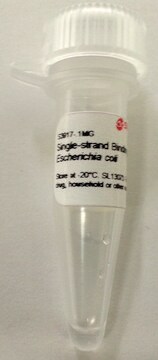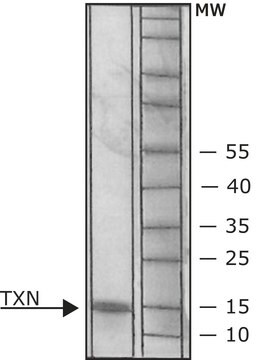F3174
Fpg Protein from Escherichia coli
≥90% (SDS-PAGE), buffered aqueous glycerol solution, >20,000 units/mg protein, suitable for genomic analysis
Synonym(s):
DNA-(apurinic or apyrimidinic site)lyase MutM (APlyase MutM), Fapy-DNAglycosylase, Formamidopyrimidine-DNA glycosylase, Fpg Protein from Escherichia coli, Recombinant, Fapy DNA glycosylase, Formamidopyrimidine DNA glycosylase, MutM
About This Item
Recommended Products
biological source
Escherichia coli
Quality Level
recombinant
expressed in E. coli
assay
≥90% (SDS-PAGE)
form
buffered aqueous glycerol solution
specific activity
>20,000 units/mg protein
mol wt
30.2 kDa (269 amino acids, predicted from the nucleotide sequence)
composition
protein, 0.1- 0.3 mg/mL Bradford
storage condition
(Tightly closed)
technique(s)
nucleic acid detection: suitable
UniProt accession no.
application(s)
genomic analysis
shipped in
wet ice
storage temp.
−20°C
Gene Information
Escherichia coli CFT073 ... mutM(1038243)
Escherichia coli K12 ... mutM(946765)
General description
Research area: Cell signaling
Application
Biochem/physiol Actions
Unit Definition
Physical form
Storage Class
10 - Combustible liquids
wgk_germany
WGK 2
flash_point_f
Not applicable
flash_point_c
Not applicable
ppe
Eyeshields, Gloves, multi-purpose combination respirator cartridge (US)
Choose from one of the most recent versions:
Already Own This Product?
Find documentation for the products that you have recently purchased in the Document Library.
Our team of scientists has experience in all areas of research including Life Science, Material Science, Chemical Synthesis, Chromatography, Analytical and many others.
Contact Technical Service






